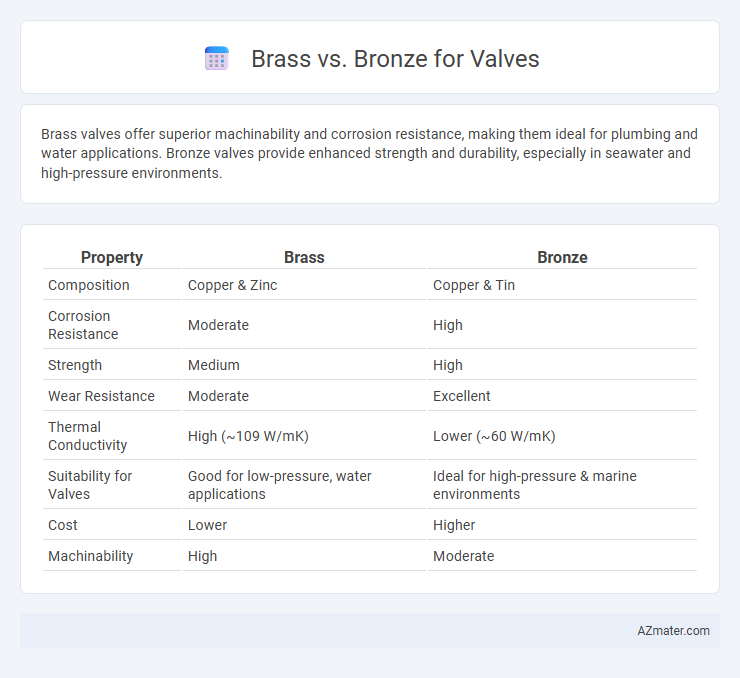Brass valves offer superior machinability and corrosion resistance, making them ideal for plumbing and water applications. Bronze valves provide enhanced strength and durability, especially in seawater and high-pressure environments.
Table of Comparison
| Property | Brass | Bronze |
|---|---|---|
| Composition | Copper & Zinc | Copper & Tin |
| Corrosion Resistance | Moderate | High |
| Strength | Medium | High |
| Wear Resistance | Moderate | Excellent |
| Thermal Conductivity | High (~109 W/mK) | Lower (~60 W/mK) |
| Suitability for Valves | Good for low-pressure, water applications | Ideal for high-pressure & marine environments |
| Cost | Lower | Higher |
| Machinability | High | Moderate |
Introduction: Brass vs Bronze Valves
Brass and bronze valves are essential components in plumbing and industrial applications, offering distinct mechanical properties and corrosion resistance levels. Brass valves typically contain copper and zinc, providing good machinability and moderate corrosion resistance, suitable for potable water systems. Bronze valves, composed primarily of copper and tin, exhibit superior strength and enhanced resistance to seawater corrosion, making them ideal for marine and high-pressure environments.
Chemical Composition Differences
Brass valves primarily consist of copper and zinc, typically containing 60-70% copper and 30-40% zinc, which provides excellent machinability and corrosion resistance. Bronze valves, in contrast, are made mainly from copper and tin, often with 88-95% copper and 5-12% tin, resulting in superior strength and enhanced resistance to wear and seawater corrosion. The higher tin content in bronze improves its durability in harsh environments, making it ideal for marine and industrial valve applications where corrosion resistance is critical.
Mechanical Properties Comparison
Brass valves exhibit higher machinability and corrosion resistance, making them suitable for applications requiring precision and durability in moderate pressure environments. Bronze valves offer superior tensile strength and fatigue resistance, providing enhanced performance under high stress and pressure conditions. Both materials have distinct mechanical properties; brass typically has a tensile strength of 300-600 MPa, whereas bronze ranges from 400-800 MPa, influencing valve selection based on operational demands.
Corrosion Resistance: Brass vs Bronze
Bronze offers superior corrosion resistance compared to brass, particularly in marine and high-chloride environments, making it ideal for valves exposed to seawater or harsh chemicals. Brass, while resistant to corrosion in general plumbing applications, is more prone to dezincification and stress corrosion cracking in aggressive conditions. Selecting bronze valves ensures longer service life and reliability in corrosive settings where brass may degrade faster.
Cost and Availability
Brass valves typically cost less than bronze valves due to the lower price of copper-zinc alloys compared to copper-tin alloys. Brass is widely available with a steady global supply chain, making it a cost-effective option for many valve applications. Bronze, though more expensive, is less common and typically sourced for specialized uses where superior corrosion resistance is required.
Typical Applications in Valves
Brass, composed primarily of copper and zinc, is widely used in valve manufacturing for water, gas, and air applications due to its excellent machinability and corrosion resistance. Bronze, an alloy of copper and tin, offers superior wear resistance and is typically preferred in marine and industrial valves where durability in harsh environments is critical. Both materials are selected based on specific requirements such as pressure tolerance, fluid compatibility, and environmental conditions in valve applications.
Machinability and Fabrication
Brass offers superior machinability compared to bronze due to its lower hardness and more uniform grain structure, facilitating faster and more precise valve fabrication processes. Bronze, while more corrosion-resistant and durable, typically requires specialized tooling and slower machining speeds because of its higher strength and toughness. Choosing brass for valve manufacturing speeds up production and reduces tooling wear, whereas bronze prioritizes longevity in harsh environments despite increased fabrication complexity.
Performance in Harsh Environments
Brass valves offer good corrosion resistance and machinability, but bronze valves excel in harsh environments due to superior resistance to saltwater corrosion and biofouling. Bronze alloys, typically composed of copper and tin, provide enhanced durability and strength under high pressure and temperature conditions commonly found in marine and industrial applications. Choosing bronze valves ensures longer service life and reliable performance in aggressive environments compared to brass alternatives.
Maintenance and Longevity
Brass valves offer excellent corrosion resistance and easier machinability, making maintenance straightforward with common tools and less frequent servicing required. Bronze valves provide superior durability in marine and industrial environments due to higher resistance to metal fatigue and erosion, leading to extended longevity under harsh operating conditions. Choosing between brass and bronze involves balancing the lower upfront maintenance of brass with the robust, long-term performance of bronze in demanding applications.
Choosing the Right Alloy for Your Valve
Selecting the right alloy for valves requires understanding the distinct properties of brass and bronze. Brass, an alloy of copper and zinc, offers excellent machinability and corrosion resistance, making it ideal for water and plumbing valves. Bronze, composed mainly of copper and tin, provides superior strength and wear resistance, suitable for valves exposed to higher pressure and marine environments.

Infographic: Brass vs Bronze for Valve
 azmater.com
azmater.com